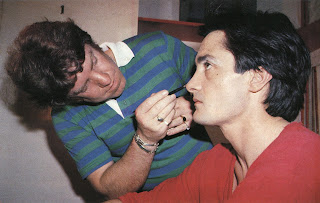The TV show
Kukla, Fran, and Ollie (about which I've written at length
here) featured Fran Allison, who stood in front of a puppet booth where she talked and sang charmingly with numerous puppet characters, all performed by Burr Tillstrom. Inspired by the apparent love between Fran and the puppets (which obviously extended behind the scenes to Tillstrom), Paul Gallico added a romantic spin, and wrote a short story which appeared in the October 28, 1950 issue of The Saturday Evening Post.
It's entitled
The Man Who Hated People, and it can be read in its entirety
here. It tells the tale of Milly Maynard, a young woman who appears on the Peter and Panda show, on which she talks to six puppet characters. The puppets are Peter (a leprechaun), Panda (a fat panda), Arthur (a raffish crocodile), Mme. Robineau (a French lady), Doctor Henderson (a stuffy penguin), and Mr. Tootenheimer (an elderly toymaker).
These puppets are performed by Crake Villeridge, a Canadian whose aborted hockey career left him with disfiguring facial scars and a dark temperament. In the story, Milly is fed up with the abusive Crake, and is leaving the show to marry Fred Archer. After what is to be her final show, she's crossing through the darkened TV studio when the puppets (as performed by Crake) call out to her from their puppet booth, begging Milly not to abandon them. Milly realizes that she is actually in love with Crake, and stays.
It's Gallico's concept of this final scene — an antisocial puppeteer using his puppets to beg a woman not to leave — that seems to have a hold on audiences. (Never mind that Tillstrom himself was a charming, handsome, gregarious gay man who clearly relished sharing the spotlight with his puppets!) It's commonly thought that Gallico adapted his Post short story into the novella
Love of Seven Dolls, which Helen Deutsch then adapted into the screenplay for the movie
Lili, which Michael Stewart then adapted into the libretto for the Broadway musical
Carnival. All of these iterations end with the same basic scene.
One problem though:
Lili premiered in 1953 but
Love of Seven Dolls wasn't published until 1954. So how could the movie be inspired by the subsequent novella? It's clear that
Lili was not simply adapted from
The Man Who Hated People. While
Lili and
Seven Dolls are quite different in tone, they do share common story elements not to be found in
The Man Who Hated, to an extent far beyond possible coincidence. In both
Lili and
Seven Dolls, the setting is changed from an American TV studio to a French carnival. A young orphan girl, rejected by the carnival, is diverted from committing suicide by a charming puppet named Carrot Top. The girl's easy rapport with Carrot Top and the other puppets (including a raffish fox named Reynardo) makes this new act the hit of the carnival, although the girl hates the bitter, antisocial man who performs the puppets. But despite a possible romantic entanglement between the girl and another performer, the bond of love between girl and puppeteer ultimately prevails. (The name "Golo" also figures in both
Lili and
Seven Dolls; Golo is a puppet in the former, the puppeteer's assistant in the latter.)
There is a "missing link" in the chain of works that takes us from
Kukla to
Carnival, and which explains the common elements between
Lili and
Seven Dolls. That link is an unpublished story by Gallico entitled
The Seven Souls of Clement O'Reilly. The credits for
Lili state only that it is "based on a story by Paul Gallico", so it's understandably assumed that this story is either
Man Who Hated or
Seven Dolls. But the
Clement O'Reilly title surfaces in August of 1951, where a syndicated newspaper story lists it as actress Pier Angeli's next film for MGM. Ralph Meeker and Fernando Lamas are later listed as cast members. Of course, this is the film that, with a different cast, would ultimately become
Lili. In July of 1953, another newspaper story announcing the film's release notes that it is based on Gallico's original story
The Seven Souls of Clement O'Reilly.
So it seems clear that Gallico first adapted
The Man Who Hated People into
The Seven Souls of Clement O'Reilly. This is where the French carnival setting came into play, and all the other elements that
Seven Dolls shares with
Lili. He then adapted
Clement O'Reilly into his
Seven Dolls novella
. (Note that the puppeteer in
Seven Dolls, named Michel Peyrot, inherited the "wiry reddish hair" one might expect from someone named "O'Reilly".) Helen Deutsch adapted
Clement O'Reilly into
Lili, adding her own plot points, and renamed the puppeteer Paul Berthalet. And finally,
Lili was adapted into
Carnival. While this task was first attempted by Deutsch herself, the musical's director Gower Champion was unhappy with the results, and brought in Michael Stewart for the job.
But interestingly, while
Carnival is officially credited as "based on material by Helen Deutsch", buried in the original Playbill program it also states "
Carnival was originally based upon a story entitled
The Seven Souls of Clement O'Reilly by Paul Gallico."
The Paul Gallico papers are housed at Columbia University; perhaps the
O'Reilly story is in there?
































